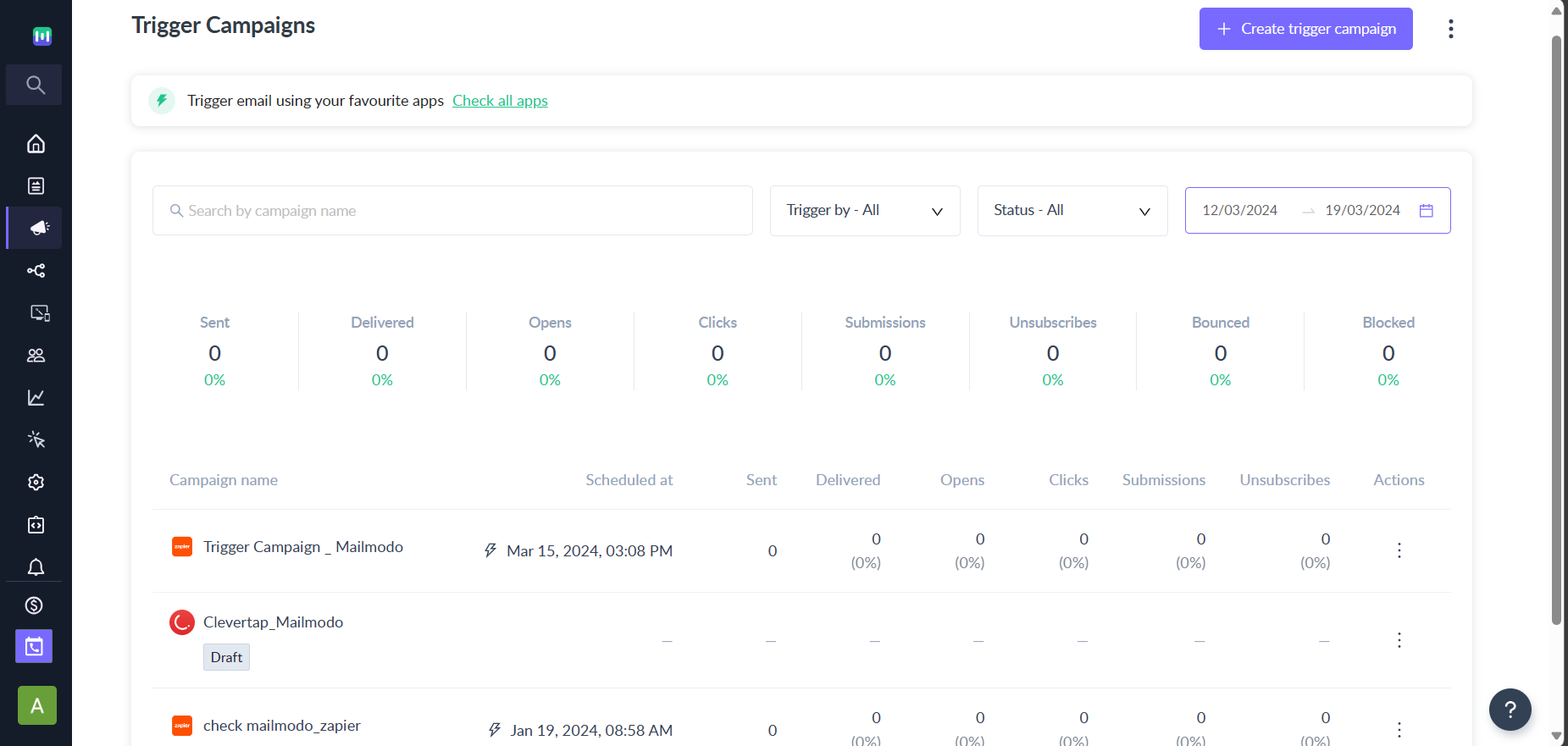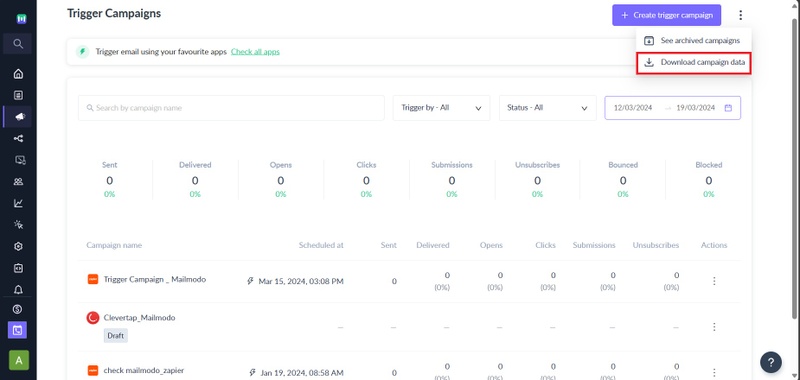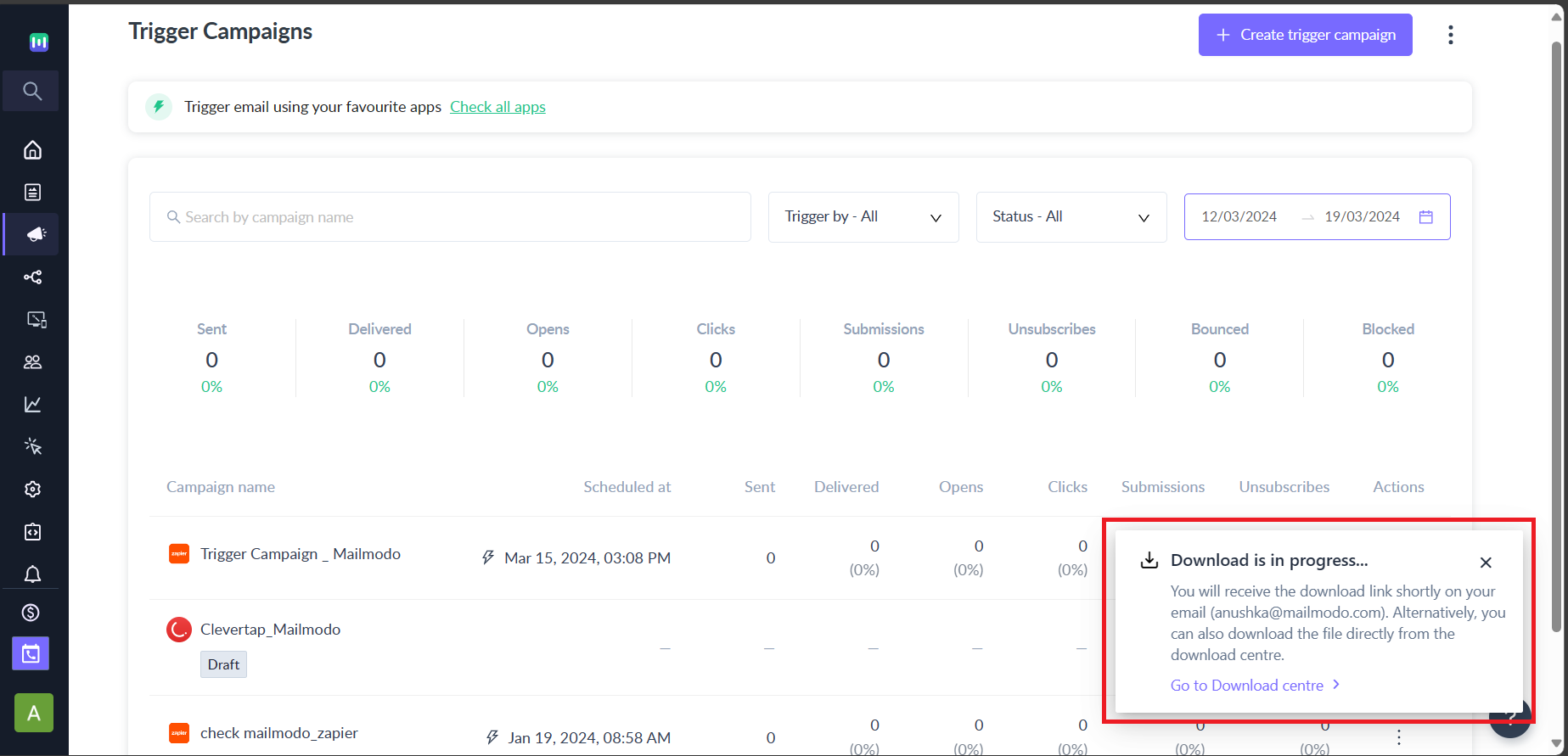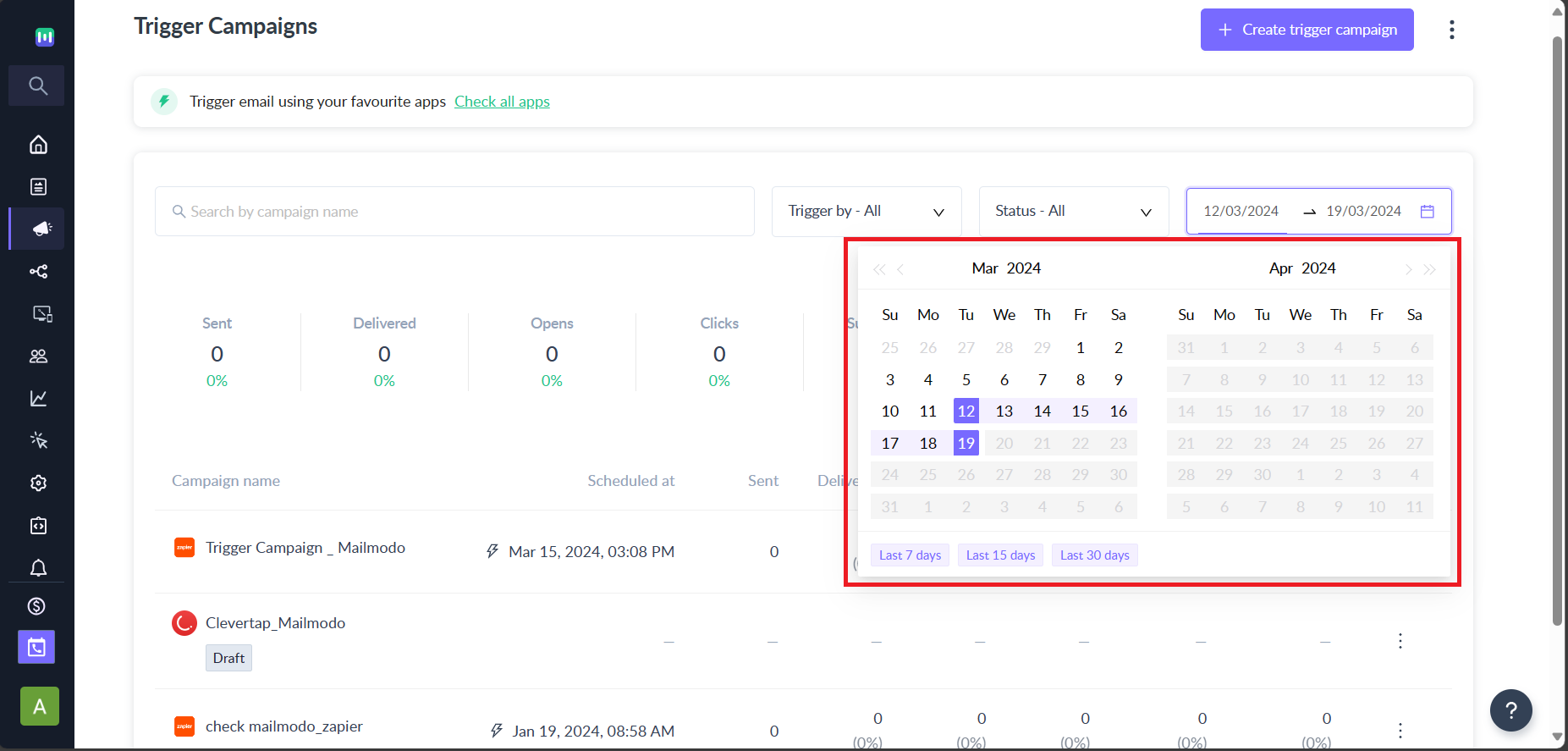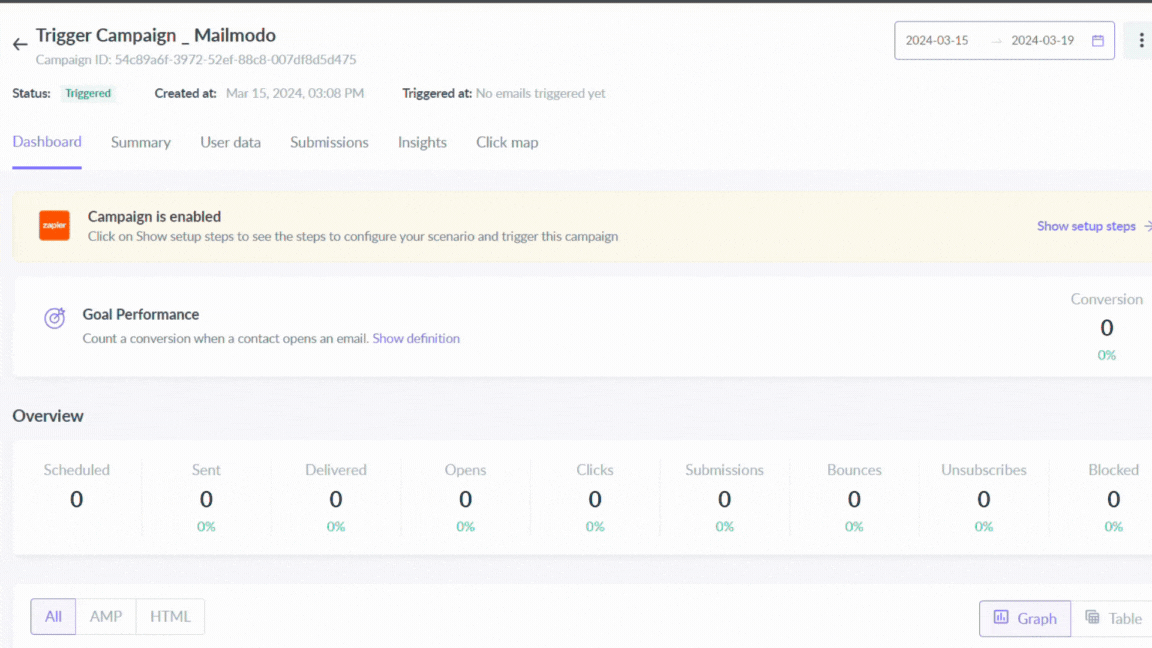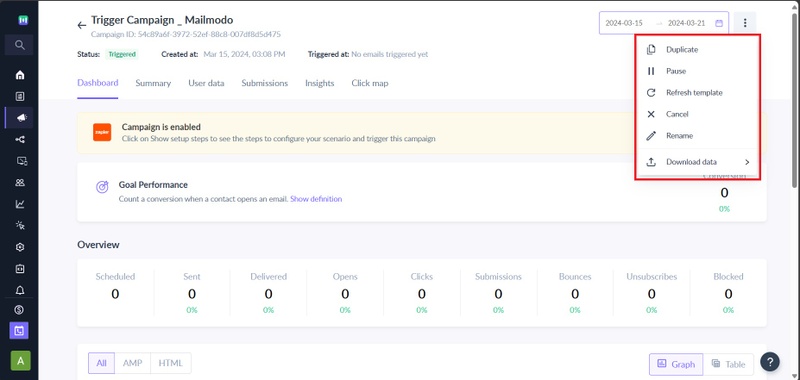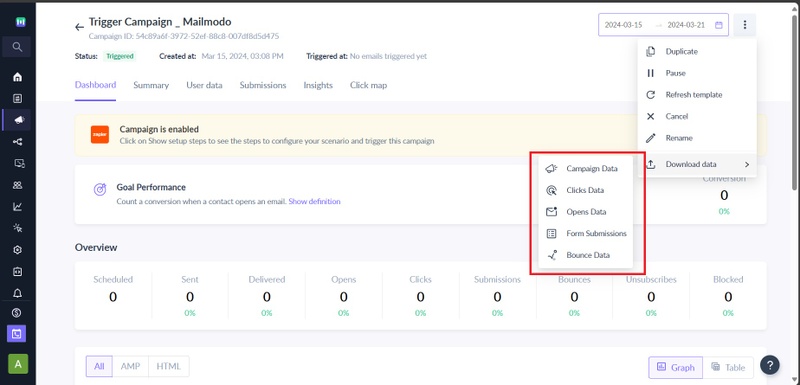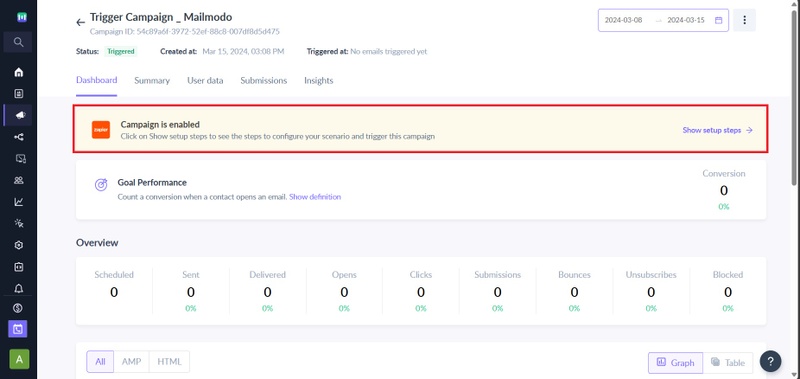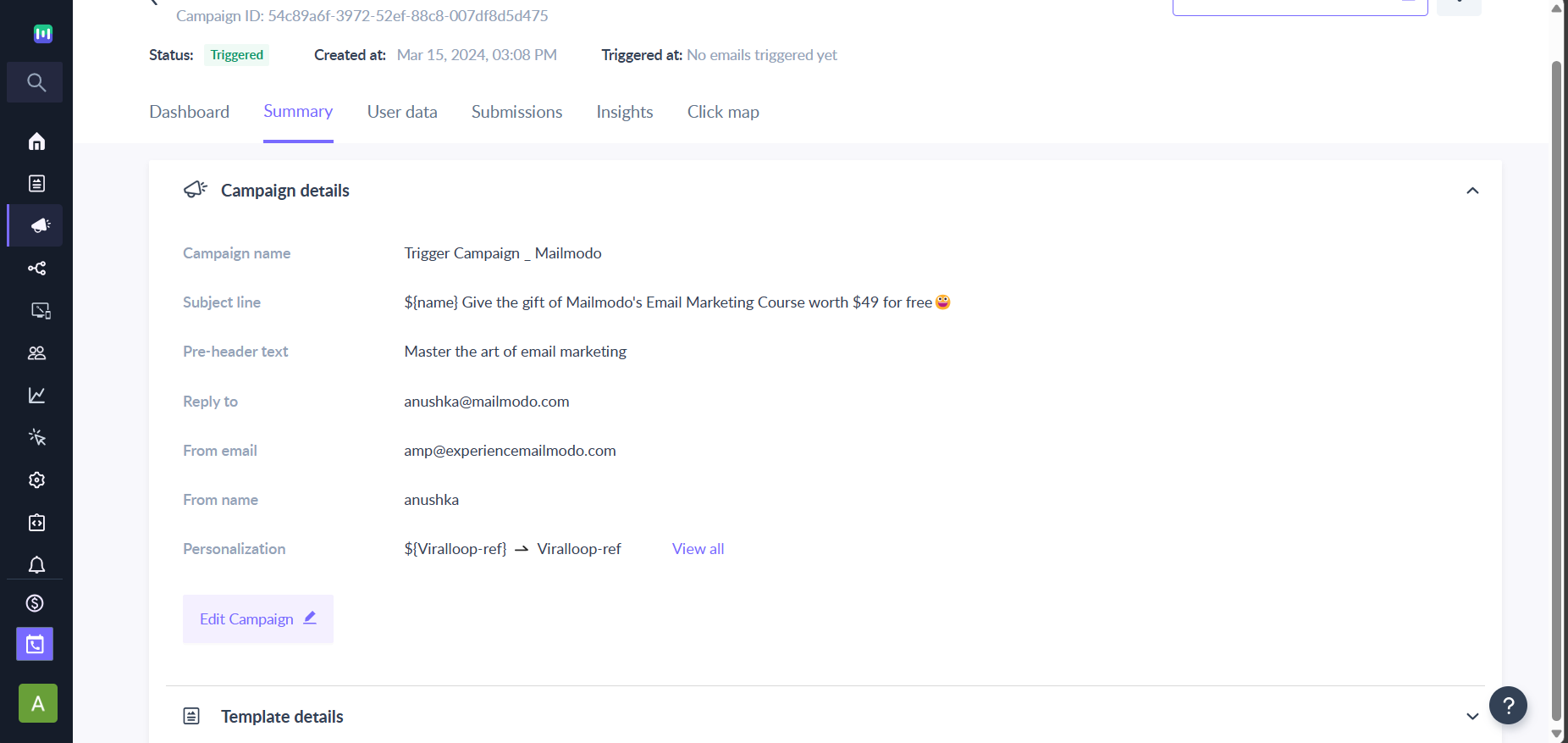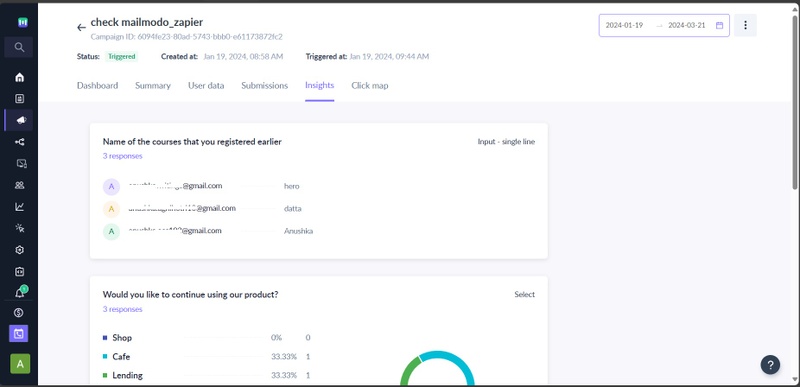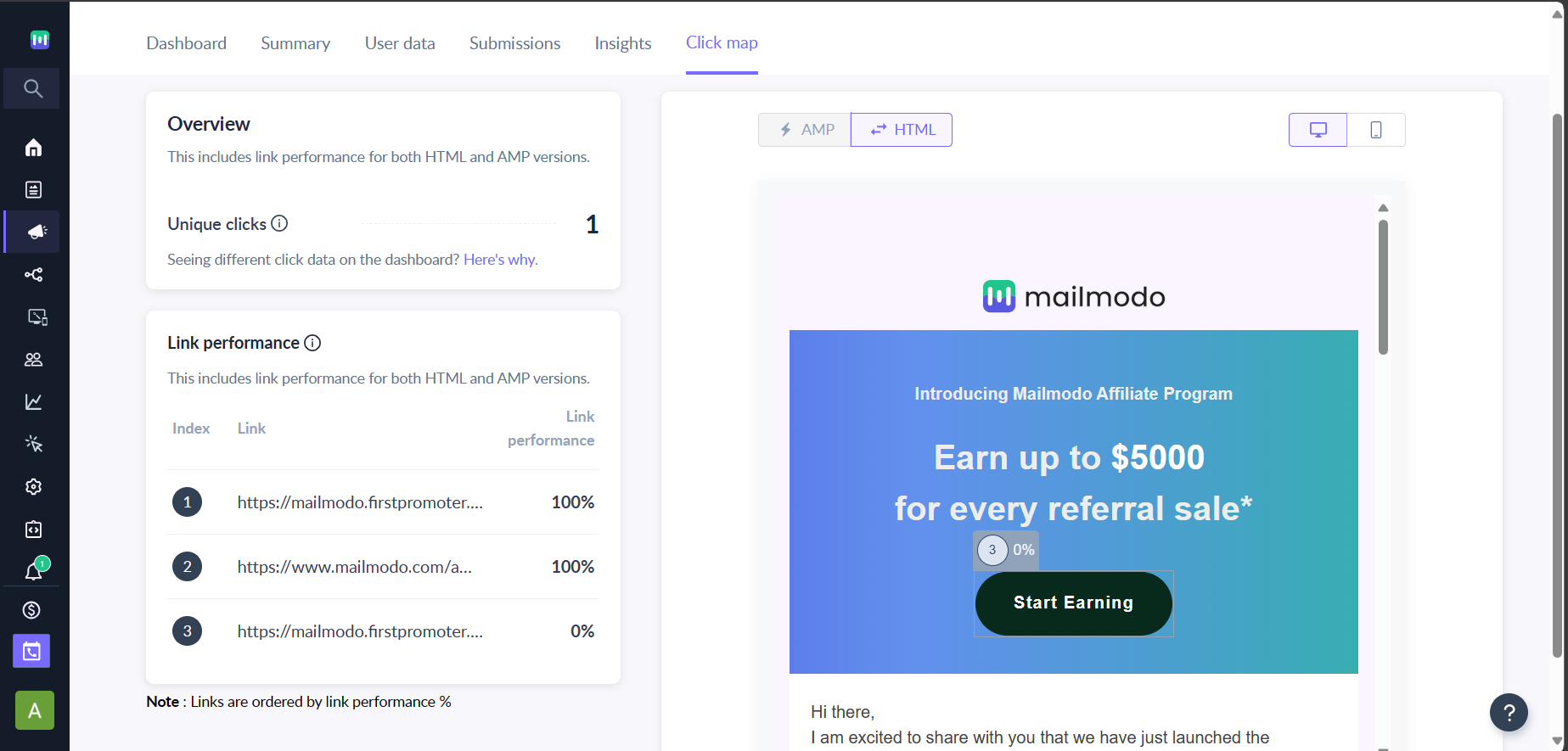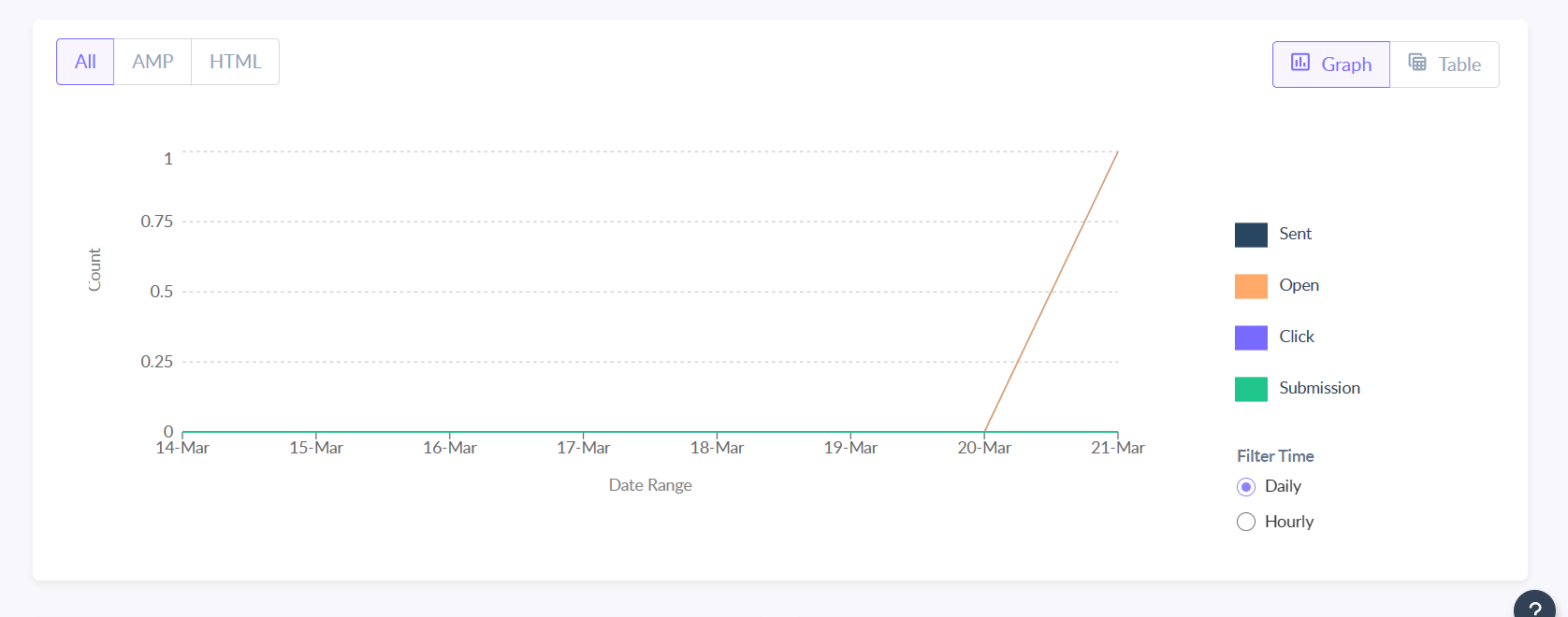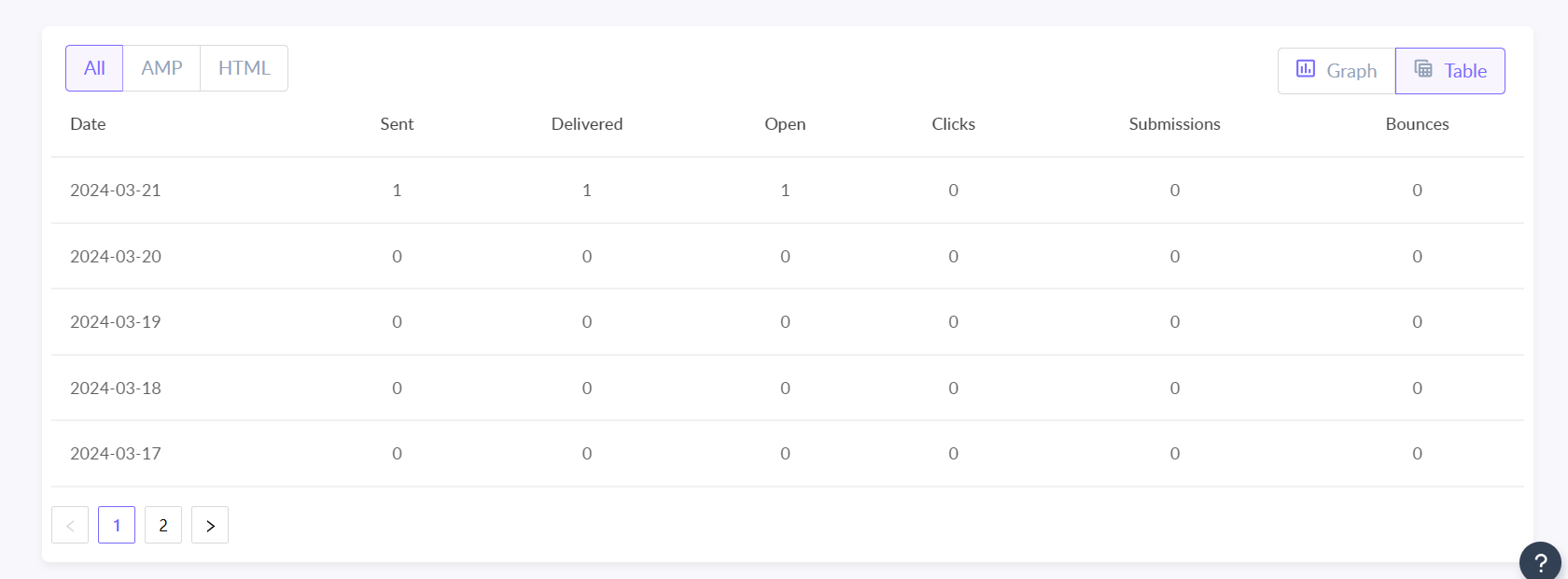Trigger Campaign Dashboard
Last updated November 4, 2025
The overall dashboard is a report that gives you a clear idea of how your campaigns are progressing. It measures the performance of your campaigns by tracking all the relevant metrics like click rate, open rate, submissions, etc.
With these metrics, you can make an educated decision on what your users like and what they don’t.
✨ Powered by Mailmodo AI — Try it out today Mailmodo AI helps you analyze campaign performance faster by automatically highlighting key trends and engagement patterns across your dashboard.
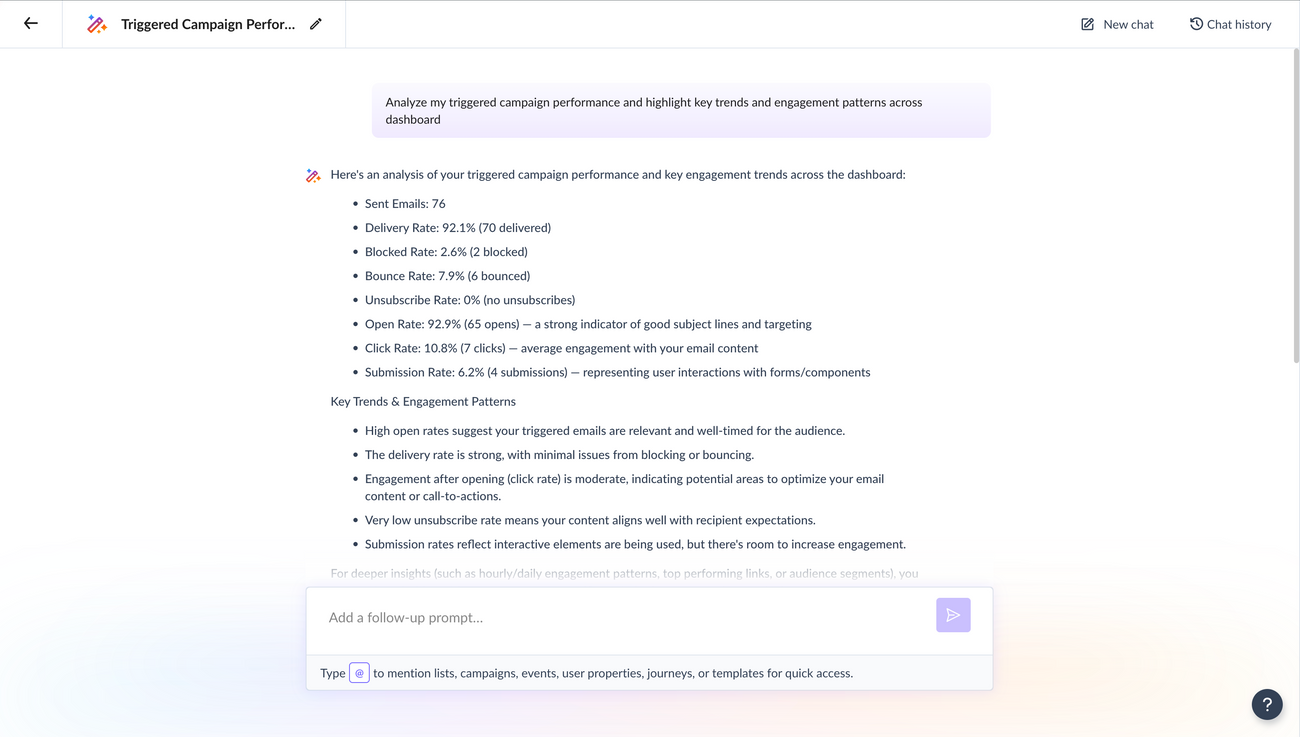
Overview of the Overall Dashboard
When you open Trigger Campaigns, you can get a cumulative report of all campaigns sent. This tells you of your company’s total outreach with all your campaigns combined. On the upper right hand side you get the option to Create trigger campaign and by clicking on the three dots beside it you can download campaign data and see archived campaigns.
Download Campaign Data (Overall Dashboard)
The Download Campaign Data action on the overall dashboard lets you import data of all your campaigns in one CSV file.
Date-wise filter
With the Date-wise filter, you can see the overall performance of your campaigns over a particular period of time. Just enter the dates in the given calendar as shown below.
Overview of the Individual Dashboard
There are multiple sections of the report that gives you an in-depth summary of your campaign. There are six sections - Dashboard, Summary, User Data, Submission, Insights and Click map.
It looks like this:
Now let’s see what actions you can perform on the individual dashboard.
Actions on Individual Dashboard
Here are the actions you can take on the individual campaign dashboard:
Duplicate
The Duplicate button is used to make a copy of any previous campaign. When you click on Duplicate, the details of the campaign that was opened get copied and pasted into the start of a new campaign. You don’t have to fill in the subject line, preheader text, from name, etc.
Pause/Resume
When a trigger campaign is launched, it goes on forever. It means that any submission or signup will trigger a response as long as the campaign is running. It will only stop when you click on the Pause button.
After clicking on Pause, the button will show Resume, which means the campaign is paused and is ready to be continued.
Refresh template
This button is used to make sure any changes made to the template while the campaign is running get reflected in the campaign.
For example, if a template has the line “Join now to get 35% off”. You changed it to “Join the list for 50% off”. The refresh button ensures the change you made gets updated in the ongoing campaign.
Cancel
When you click on Cancel, a window pops up showing it is a non-reversible action and it will stop the ongoing campaign. It means the signups or submissions will not trigger any event.
Rename
When you click on Rename, you get a dialog box, which allows you change the name of the campaign.
Download Data (Individual Dashboard)
This button is used to export different kinds of data from a campaign.
You can export 5 types of data - Campaigns Data, Clicks Data, Opens Data, Form Submissions and Bounce Data. Just click on Download Data to choose the aforementioned options.
When you click on either of the five, the data gets exported to a CSV file.
Campaign Data
This tells you the overall details related to a campaign like HTML opens, amp opens, HTML clicks, AMP clicks, etc. When you click on Campaigns Data, a CSV file gets sent to your account which contains all the information you need.
You can get the data for both bulk campaigns and trigger campaigns.
Clicks Data
Clicks Data or Click-through rate data is the proportion of people or subscribers who click on a particular link out of the total users who view the email.
CTR (click-through rate) is often considered a reliable metric while measuring the performance of a campaign. But campaigns with multiple links or CTAs, knowing what’s getting the most clicks can help you create better campaigns in the future.
You can obtain the clicks data for normal bulk campaigns as well as trigger campaigns.
Refer to Link Wise Click Tracking to learn how to export the clicks data.
Dashboard
The individual campaign dashboard is a visual report that gives you a clear idea of how your individual campaigns are progressing. It measures metrics like clicks, opens, submissions, etc., to better understand what your users like and helps you send campaigns according to their preferences.
Show setup steps
This page shows you the Webhook URL that will be generated. Use this webhook URL in your desired platform. The campaign will be triggered based on actions or events recorded on your platform.
The following parameters are tracked for every email campaign sent via Mailmodo:
Sent
It's the number of emails sent in the campaign.
Sent %: Emails Sent / Emails Scheduled.
Delivered
It's the number of emails that were delivered to the recipients.
Delivery % : Emails Delivered / Emails Sent.
Open
It's the number of unique recipients who have opened the campaign.
Open Rate: Emails Opened / Emails Delivered.
Clicks
It's the number of subscribers who ‘click’ on at least one link in the email.
Click to Open Rate : Clicks / Opens
Submission
It's the number of subscribers who submitted the form in the email.
Submission Rate : Submissions / Opens
Bounce
It's the number of hard and soft bounces from the subscriber list.
Bounce Rate: Bounces / Emails Sent
Unsubscribe
It's the number of contacts who have unsubscribed (from your list).
Unsubscribe Rate: Unsubscribes / Emails Delivered
Blocked
It's the number of contacts that were not sent this campaign because they unsubscribed or got bounced in the past.
Blocked %: Emails Blocked / Emails Scheduled
Summary
This tab shows you the campaign details, and template details.
Under Campaign Details, you have the campaign’s name, the name of the template you’ve used, pre-header text, subject line(s), reply-to email, from email, and personalization.
Under Template details use can view how your email would have looked to the recipients.
User Data
It shows you the relevant data for every contact you have sent the campaign to. It shows stats like Open Html, Open Amp, Click Html, Click Amp, etc.
Open Html means how many times the email’s HTML version was opened. Open Amp means how many times the email’s AMP version was opened.
The same goes for Click Html and Click Amp. It shows the number of AMP/HTML elements the recipients have clicked in the email.
Submissions
The responses of the form, quizzes, polls, etc., designed in the email template get stored in the submission tab of the analytics dashboard for every campaign.
Insights
It shows you a generic view of the responses submitted by the recipients.
Click Map
It shows the performance of links in the mail you sent.
Graphs/Visual Representation
It shows a graphical representation of the campaign’s performance which is color-coded to better differentiate between the metrics on the graph.
You can view the graph for AMP as well as HTML in case you want to see how they performed in comparison to each other.
Also, the AMP vs HTML performance is shown in a table below the graph under ‘Performance Summary’.
If you wish to see a tabular view, click on the table view toggle button. The table will look something like this:
If you face any problem then reach out to us at Mailmodo Support or share your thoughts at Mailmodo Product Feedback .
Why do I see a difference in the campaign dashboard overview data and the engagement report data?
At times, you might encounter a situation where the data in the campaign dashboard overview is different from the engagement report data even when the date filters that you are using the same.
This happens due to a fundamental change in how we filter the data in both the places.
In the overview data, the date filter is applied only to the email's scheduled time. This means we show all emails scheduled between date X and date Y, along with their metrics like opens and clicks, regardless of when those actions occurred.
On the other hand, the engagement trend report applies the date filter to all metrics. This means it shows the number of opens, clicks, and other actions that happened on each specific date.
Now, let's understand this with an example:
- You schedule an email on July 24th.
- The scheduled count is 10, and the email is delivered to all 10 contacts on July 24th.
- Email is opened by 2 contacts on July 26th.
- You apply the date filter only for July 24th.
| Report | Sent | Delivered | Opened |
| Overview Data | 10 | 10 | 2 |
| Engagement Report Data | 10 | 10 | 0 |
The overview report data will show the sent, delivered and open count, while the engagement report will not show the opens since they occurred on a different date.


